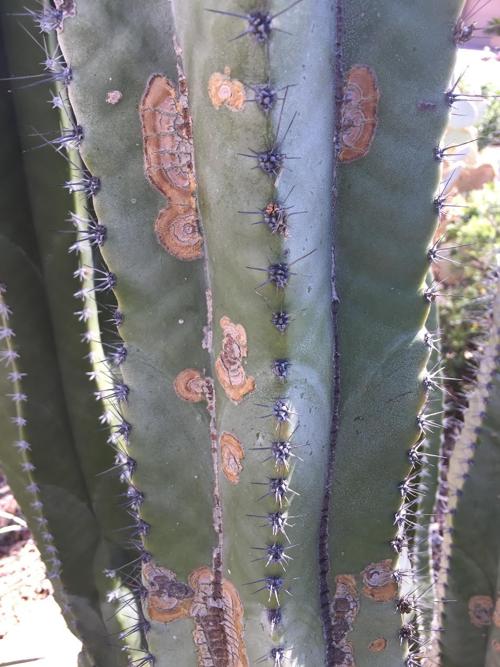Q: What can we do to save the life of our beloved cactus! It started in December with some of the brown spots and now it is spreading. It has always been protected for frost with Styrofoam cups on tips and a burlap wrap. We have noticed other cacti (Mexican Fence Post) here in Saddlebrooke have the same markings. Any help would be greatly appreciated.
A: Brown spots on cacti may be caused by a few different things including too much sun on newly planted cacti, damage from animals, frost, hail, some pesticides, and diseases. The spots on your cacti appear to be fungal lesions that sometimes occur when we have cool, wet weather as we did this winter. The damage is usually cosmetic and won’t cause the death of the plant but it is also irreversible so it will remain as a scar. Now that summer-like weather has begun you should see less of this disease occurring in your neighborhood.
Q: We had a mountain laurel tree planted in March of 2016. Thought we followed the instructions for watering before leaving for Minnesota in May. While we were gone it was watered by the drip system. On our return in October the leaves were light green so took a sample to Civano Nursery and they said it showed that there was too much salt from not being watered deep enough. They recommended watering on a slow drip for ⅔ hours once a week, which we’ve been doing. The leaves are still pale green, not showing any improvement. Now we’re wondering if there’s any way to save the tree. Do you have any advice for us?
A: Given our salty soil and the salt contained in fertilizers, it is certainly possible your tree has an excess of salt in the root zone. A soil test would confirm this diagnosis but watering it deeply might confirm as well. The watering schedule they suggest is good for newly planted trees. Since your tree has been in the ground for a year, you can back it off a bit and water deeper. Established Texas mountain laurel trees should be watered deeply every two or three weeks to a depth of 24 to 36 inches to effectively wash the salt through the root zone. Because not all drip systems are created equal, it would be good to measure the water depth with a soil probe to make sure the running time is correct. A soil probe can be as simple as a piece of rebar that you push into the ground after irrigating to see how deep the water went. Dry soil will provide more resistance than the wet stuff and that’s how you will know when to pull out and measure the depth.
Peter L. Warren is the Forest Health Program Coordinator for the Arizona Department of Forestry and Fire Management. Questions, photos and videos may be emailed to tucsongardensage@gmail.com





